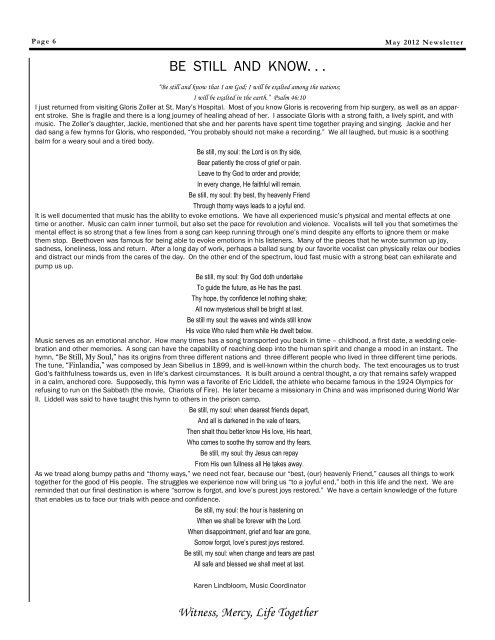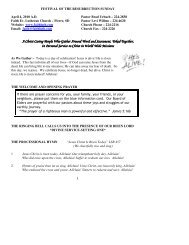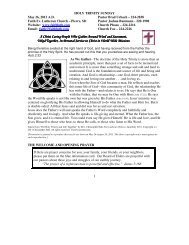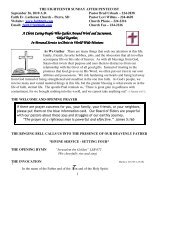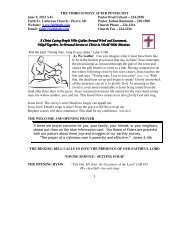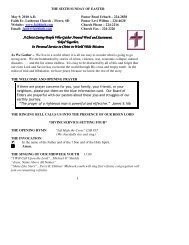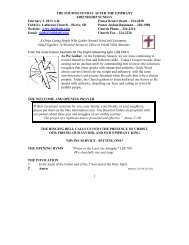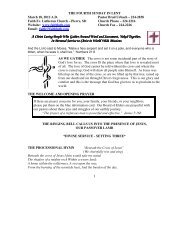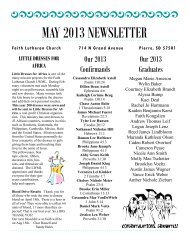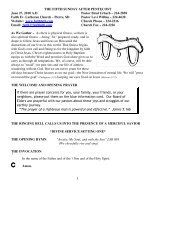JYM NEWS - Faith Evangelical Lutheran Church
JYM NEWS - Faith Evangelical Lutheran Church
JYM NEWS - Faith Evangelical Lutheran Church
Create successful ePaper yourself
Turn your PDF publications into a flip-book with our unique Google optimized e-Paper software.
Page 6<br />
BE STILL AND KNOW. . .<br />
“Be still and know that I am God; I will be exalted among the nations;<br />
I will be exalted in the earth.” Psalm 46:10<br />
I just returned from visiting Gloris Zoller at St. Mary’s Hospital. Most of you know Gloris is recovering from hip surgery, as well as an apparent<br />
stroke. She is fragile and there is a long journey of healing ahead of her. I associate Gloris with a strong faith, a lively spirit, and with<br />
music. The Zoller’s daughter, Jackie, mentioned that she and her parents have spent time together praying and singing. Jackie and her<br />
dad sang a few hymns for Gloris, who responded, “You probably should not make a recording.” We all laughed, but music is a soothing<br />
balm for a weary soul and a tired body.<br />
Be still, my soul: the Lord is on thy side,<br />
Bear patiently the cross of grief or pain.<br />
Leave to thy God to order and provide;<br />
In every change, He faithful will remain.<br />
Be still, my soul: thy best, thy heavenly Friend<br />
Through thorny ways leads to a joyful end.<br />
It is well documented that music has the ability to evoke emotions. We have all experienced music’s physical and mental effects at one<br />
time or another. Music can calm inner turmoil, but also set the pace for revolution and violence. Vocalists will tell you that sometimes the<br />
mental effect is so strong that a few lines from a song can keep running through one’s mind despite any efforts to ignore them or make<br />
them stop. Beethoven was famous for being able to evoke emotions in his listeners. Many of the pieces that he wrote summon up joy,<br />
sadness, loneliness, loss and return. After a long day of work, perhaps a ballad sung by our favorite vocalist can physically relax our bodies<br />
and distract our minds from the cares of the day. On the other end of the spectrum, loud fast music with a strong beat can exhilarate and<br />
pump us up.<br />
Be still, my soul: thy God doth undertake<br />
To guide the future, as He has the past.<br />
Thy hope, thy confidence let nothing shake;<br />
All now mysterious shall be bright at last.<br />
Be still my soul: the waves and winds still know<br />
His voice Who ruled them while He dwelt below.<br />
Music serves as an emotional anchor. How many times has a song transported you back in time – childhood, a first date, a wedding celebration<br />
and other memories. A song can have the capability of reaching deep into the human spirit and change a mood in an instant. The<br />
hymn, “Be Still, My Soul,” has its origins from three different nations and three different people who lived in three different time periods.<br />
The tune, “Finlandia,” was composed by Jean Sibelius in 1899, and is well-known within the church body. The text encourages us to trust<br />
God’s faithfulness towards us, even in life’s darkest circumstances. It is built around a central thought, a cry that remains safely wrapped<br />
in a calm, anchored core. Supposedly, this hymn was a favorite of Eric Liddell, the athlete who became famous in the 1924 Olympics for<br />
refusing to run on the Sabbath (the movie, Chariots of Fire). He later became a missionary in China and was imprisoned during World War<br />
II. Liddell was said to have taught this hymn to others in the prison camp.<br />
Be still, my soul: when dearest friends depart,<br />
And all is darkened in the vale of tears,<br />
I N S I D E S T O R Y H E A D L I N E<br />
Then shalt thou better know His love, His heart,<br />
Who comes to soothe thy sorrow and thy fears.<br />
This story can fit 75-125<br />
Be still, my soul: thy Jesus<br />
from<br />
can<br />
which<br />
repay<br />
you can choose<br />
words.<br />
and import into your newslet-<br />
From His own fullness all ter. He There takes away.<br />
Selecting pictures or graphics<br />
are also several<br />
As we tread along bumpy paths and “thorny<br />
is an important<br />
ways,” we<br />
part<br />
need<br />
of adding<br />
not fear, because tools you our can “best, use (our) to draw heavenly Friend,” causes all things to work<br />
together for the good of His people. The struggles we experience now will<br />
content to your newsletter. shapes bring us and “to symbols. a joyful end,” both in this life and the next. We are<br />
reminded that our final destination is where “sorrow is forgot, and love’s<br />
Think about your article and Once<br />
purest<br />
you<br />
joys<br />
have<br />
restored.”<br />
chosen<br />
We<br />
an<br />
have a certain knowledge of the future<br />
that enables us to face our trials with peace and confidence.<br />
ask yourself if the picture image, place it close to the<br />
supports or enhances Be still, my the soul: the hour article. is hastening Be sure on to place the<br />
message you’re When trying we to shall con- be forever<br />
caption<br />
with the<br />
of<br />
Lord.<br />
the image near the<br />
vey. Avoid selecting images image.<br />
When disappointment, grief and fear are gone,<br />
that appear to be out of context.<br />
Sorrow forgot, love’s purest joys restored.<br />
Microsoft Publisher Be still, my includes soul: when change and tears are past<br />
thousands of clip All safe art images and blessed we shall meet at last.<br />
Karen Lindbloom, Music Coordinator<br />
Witness, Mercy, Life Together<br />
May 2012 Newsletter


